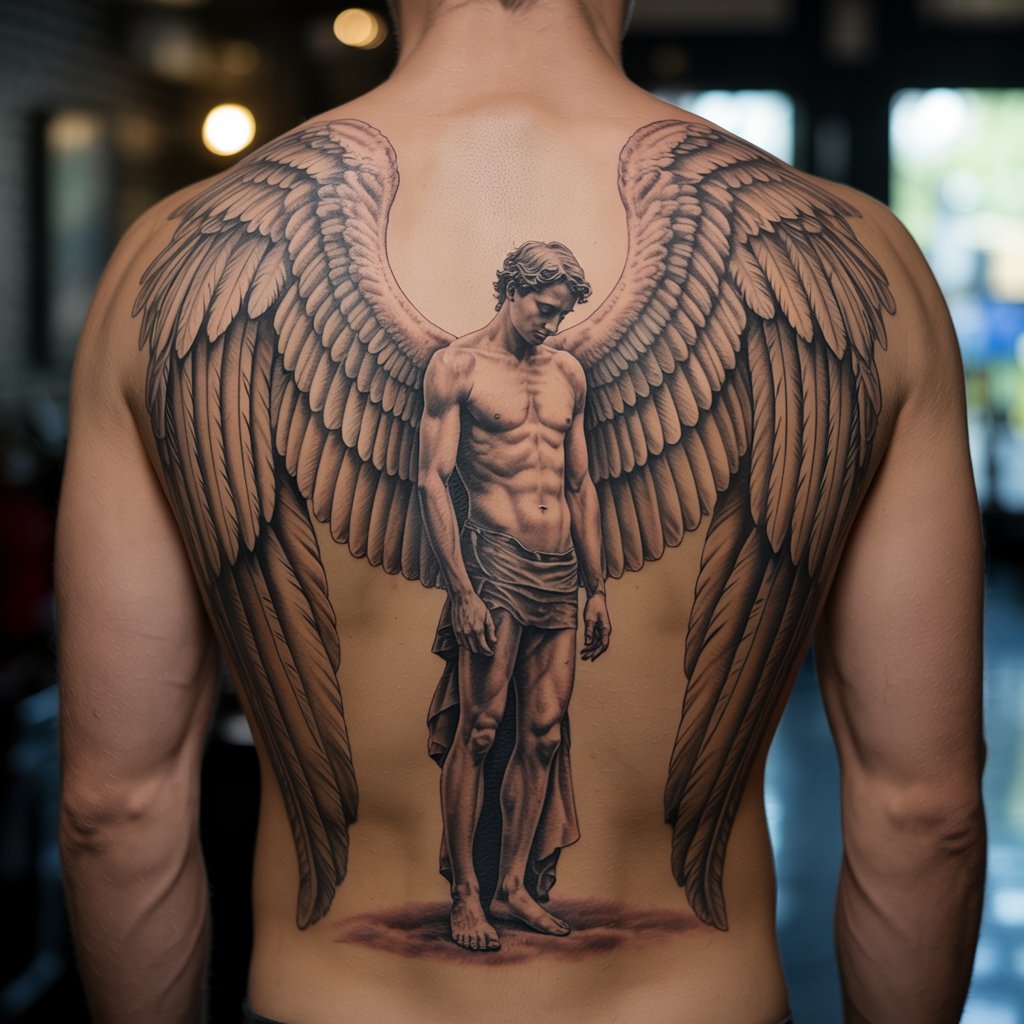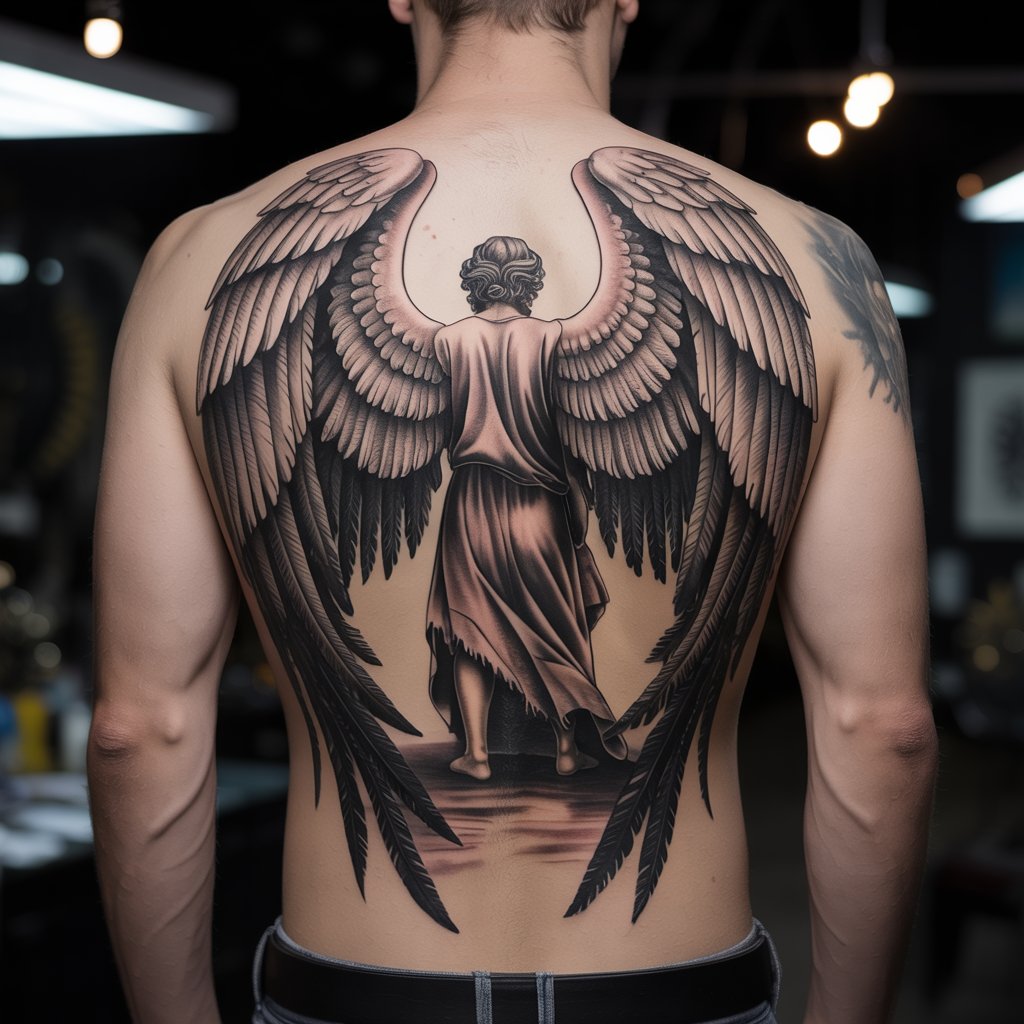In the realm of body art, few designs carry the symbolic weight and visual impact of a full-back guardian angel tattoo. These masterful pieces transform the human back into a canvas for divine protection, personal significance, and extraordinary artistic skill. As one of tattooing’s most ambitious undertakings, the angel back piece represents not just aesthetic beauty, but often a deeply personal spiritual journey marked permanently upon the skin.
The Symbolic Depth Behind Angel Wings
The decision to commit such extensive skin real estate to angelic imagery rarely comes without profound personal meaning. For many wearers, these designs represent:
- Divine protection: A guardian presence watching over the wearer through life’s challenges
- Remembrance: A tribute to loved ones who have passed, symbolically watching over from beyond
- Personal transformation: Marking significant life changes, recovery journeys, or spiritual awakening
- Moral compass: A reminder of one’s better nature and aspirations toward higher virtues
- Religious devotion: An expression of faith and spiritual connection
“These aren’t casual tattoo decisions,” explains veteran tattoo artist Miguel Ramirez. “When someone chooses an angel for their entire back, they’re usually marking something profoundly significant in their life journey. I’ve created these pieces for people honoring deceased family members, celebrating recovery from near-death experiences, or marking major spiritual transformations.”
Anatomical Canvas: Why the Back Reigns Supreme
The human back provides an unparalleled canvas for such elaborate designs, offering:
- Expansive, uninterrupted space: Allowing for complete artistic vision without compromise
- Natural symmetry: Complementing the balanced nature of angel wing imagery
- Anatomical contouring: Shoulders and shoulder blades create natural elevation for wing placement
- Limited exposure: Providing the option to conceal or reveal the artwork as desired
- Pain management: Despite size, the back generally offers more manageable pain levels than more sensitive body areas
“The back’s natural architecture seems almost designed for wings,” notes tattoo historian Dr. Elena Chen. “The shoulder blades create a natural protrusion that gives dimensional realism to wing placement, while the spine creates a perfect centerline for balanced composition.”
The Technical Mastery Required
Creating a masterful angel back piece demands exceptional technical skill from the artist:
- Scale mastery: Maintaining proportional accuracy across a large, curved surface
- Perspective control: Creating visual depth across a non-flat canvas
- Feather differentiation: Rendering multiple layers of feathers with distinct textures and dimensions
- Light and shadow work: Creating the illusion of three-dimensionality through strategic shading
- Flow integration: Ensuring the design complements the body’s natural movement
- Fabric rendering: Depicting realistic cloth draping on the angelic figure
- Session management: Executing consistent quality across multiple lengthy sessions
“These pieces typically require anywhere from 30 to 50 hours of tattooing,” explains award-winning tattoo artist Sofia Lin. “That’s spread across multiple sessions over months, sometimes even years. The commitment from both artist and client is immense, but that shared journey often creates a special bond through the process.”
Stylistic Approaches to Angelic Imagery
While traditional guardian angel imagery maintains popularity, artists continue to evolve the concept through various stylistic approaches:
- Classical renaissance: Drawing from Michaelangelo and other masters’ angelic depictions
- Gothic interpretation: Darker, more somber angel imagery with medieval influences
- Blackwork emphasis: Using bold blacks and negative space for dramatic contrast
- Realism: Photo-realistic rendering of wing structure and human anatomy
- Neo-traditional: Bolder lines and stylized elements while maintaining classical subjects
- Black and gray: The most common approach, utilizing grayscale shading for dimensional depth
“What makes these pieces so compelling is how they blend ancient symbolism with modern tattooing techniques,” says art historian Marcus Wei. “The conceptual roots might trace back to renaissance paintings, but their execution employs cutting-edge tattooing approaches that weren’t possible even a decade ago.”
The Physical and Emotional Journey
Committing to a full back guardian angel tattoo involves far more than aesthetic considerations:
- Physical endurance: Multiple sessions of 3-8 hours each over months
- Financial investment: Premium work typically ranging from $3,000 to $10,000 or more
- Aftercare dedication: Meticulous healing care across a large, difficult-to-reach area
- Lifestyle adaptation: Temporarily modifying sleep positions, clothing choices, and activities
- Emotional processing: Working through the psychological significance throughout the creation process
“Getting my guardian angel was like therapy through pain,” shares tattoo recipient James Cortez. “Each session forced me to sit with my grief for my brother while simultaneously creating something beautiful from that loss. By the final session, I felt transformed both physically and emotionally.”

The Lifetime Relationship
Unlike smaller tattoos that might eventually blend into one’s self-image, a guardian angel back piece creates a permanent relationship between wearer and artwork:
“You don’t just ‘have’ an angel back piece—you live with it,” explains cultural anthropologist Dr. Sarah Mahmoud. “It becomes part of your identity, something you’re conscious of even when you can’t see it. There’s something powerful about carrying such significant imagery in a place you yourself rarely view directly. It’s there more for the world than for your own eyes, yet it remains deeply personal.”
This paradox—of wearing something so personal in a location one rarely sees directly—creates a unique psychological relationship with the artwork. It becomes simultaneously the most private and most public statement a person can make with their body.
The Healing Power of Angelic Imagery
Beyond aesthetic appeal, many recipients report therapeutic benefits from their guardian angel tattoos:
- Grief processing: Creating a permanent memorial for loved ones
- Recovery marking: Celebrating triumph over addiction, illness, or trauma
- Protection sense: Fostering feelings of safety and divine connection
- Identity integration: Reconciling spiritual beliefs with physical embodiment
- Life transition marking: Creating a permanent boundary between different life chapters
“I started the process feeling broken and ended it feeling protected,” explains tattoo recipient Maria Sanchez. “Every time I glimpse my wings in the mirror, I’m reminded that I’m carrying my grandmother’s protection with me everywhere I go.”
A Timeless Art Form Evolving
As tattooing techniques continue advancing, the guardian angel back piece remains a pinnacle achievement in the medium—a perfect marriage of technical skill, symbolic depth, and personal significance. These pieces transform not just the skin but often the wearer’s relationship with their own life journey.
For those considering such a significant commitment, veteran tattoo artists recommend extensive research, careful artist selection, and deep reflection on personal meaning. The resulting artwork offers not just remarkable beauty but a permanently inscribed reminder of protection, guidance, and spiritual connection—a guardian who never leaves your side.


